Edition One
Surveillance Index Edition One is a collection of one hundred books related to surveillance photography.
Books are indexed by Year, Title, Photographer, Description, Size, and Code.
2023 Welcome to the machine and long polling cameras that connect to AI for X
Now available through Twelve Books in Japan
アメリカ人インターネット起業家、マーク・グネイム(Mark Ghuneim)の作品集。監視写真に関連する100冊の本をまとめた包括的な参考資料集。本書は、監視とそこから生まれたイメージが私たちの生活にとって切っても切り離せない一部となった時代と、アーティストたちが向かい合ってきた主題の記録である。収録されている文化評論家のカーロ・マコーミック(Carlo McCormick)のエッセイ『The Eyes Have It』は、歴史的な背景を説明し、この監視という劇場に先立って存在する美術史の中の例を詳細に分析する。本書は参考資料としてデザインされており、全ての作品が出版年、題名、撮影者、解説、サイズ、コードで索引付けされている。さらに各冊の代表的な見開きページと独自の説明に加え、全ての収録書籍が掲載されたポスター、オリジナルバッグ付き。
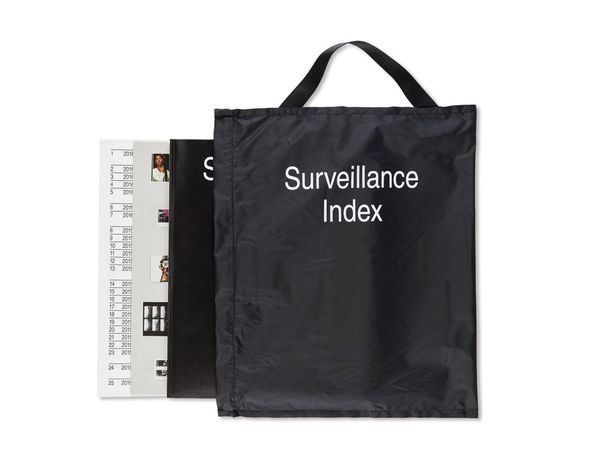
Each edition of the book now ships with new black and silver tote bags.
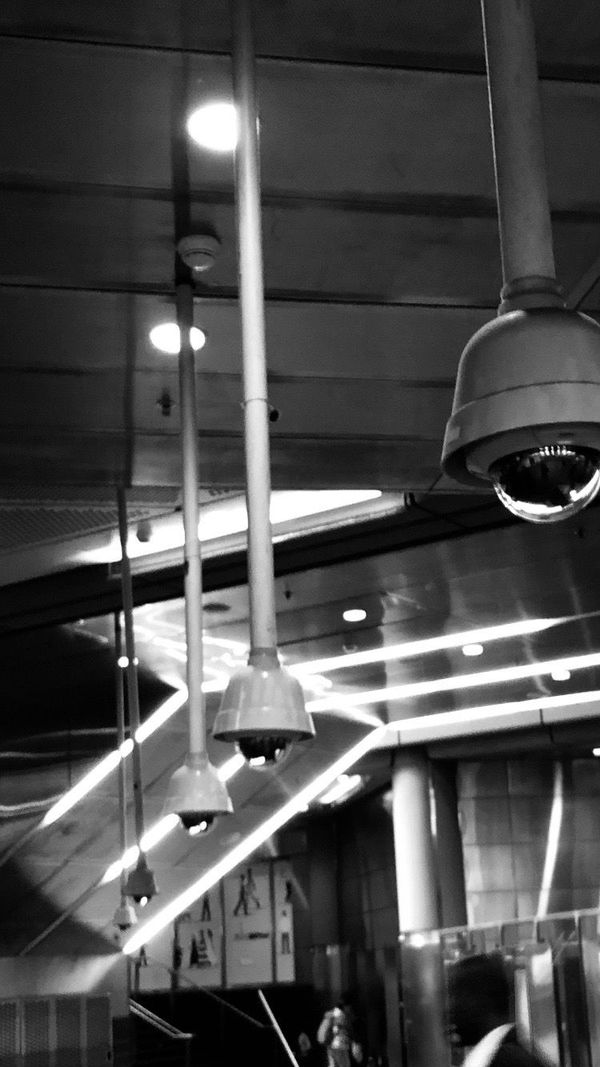
Tim Head - The Tyranny of Reason this may be the one of the first art/photography books that deals with public surveillance
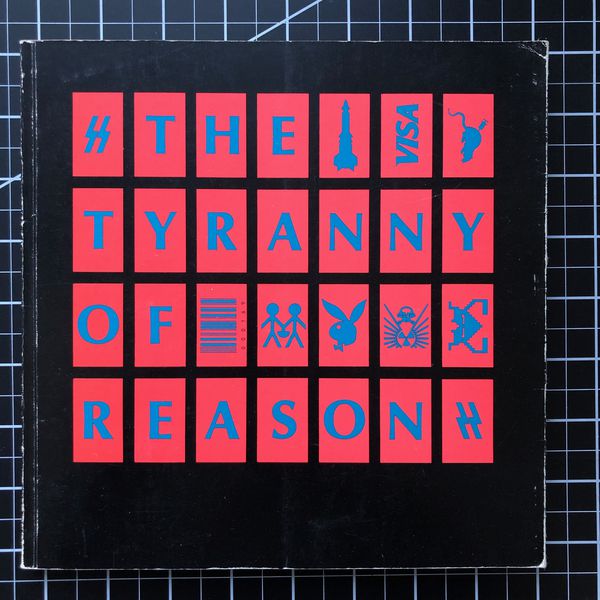
surveillance photography
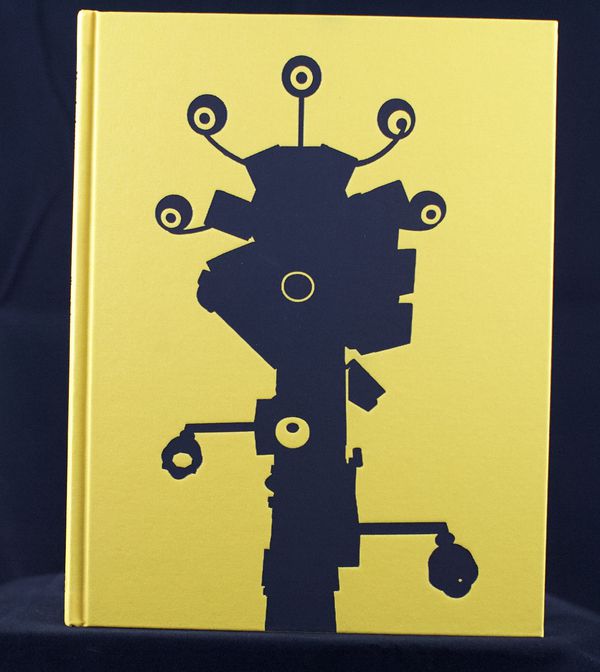
Archiv Peter Piller
Piller, Peter
Lingering Ghosts
Irvin, Sam
Zus
Fougeirol, Benoît
MY TV Girls
Girard, Sebastien
Restricted Images: Made with the Warlpiri of Central Australia
Waterhouse, Patrick
Palimpsest
Braquenier, Philippe
Robert F. Kennedy Funeral Train: The People’s View
Terpstra, Rein Jelle
Phenotypes/Limited Forms
Linke, Armin; Hanappe, Peter
New York
Gozu, Masao
Art Peace China Daily
Joachim Schmid
Are You Searching For Me?
Joachim Schmid
X Marks the Spot
Joachim Schmid
The Diary of Tom Wilkins
Girard, Sebastien
Sixty-Eight Minutes on the Sunset Strip
Joachim Schmid
The book - From the inaugural ICP exhibition of the same title (co-curated and named by yours truly) This publication came out exceptional.
Public, Private, Secret: On Photography and the Configuration of Self By Charlotte Cotton .
With Marina Chao and Pauline Vermare Contributions by Lacy Austin, David A. Banks, Ben Burbridge, Dan Bustillo, common room, Mark Ghuneim, Johanna Hedva, Romke Hoogwaerts, Elizabeth Kilroy, Joseph Maida, Marisa Olson, David Reinfurt, Daniel Rubinstein, and Lucas Wrench Interviews with Merry Alpern, Zach Blas, Natalie Bookchin, Nancy Burson, Kate Cooper, Lyle Ashton Harris, Ann Hirsch, John Houck, Trevor Paglen, Martine Syms, and Shelly Silver
Copublished by Aperture and the International Center of Photograph
Visvaldas Morkevicius - Public Secrets
Wikiland 23/6/17
RAF No Evidence - Kein Beweis
DMZ - Park Jung Woo
Shadows of the State - Lewis Bush
False Positives - Esther Hovers

The first edition of PERFORMING BOOKS at LE BAL was dedicated to SURVEILLANCE INDEX.
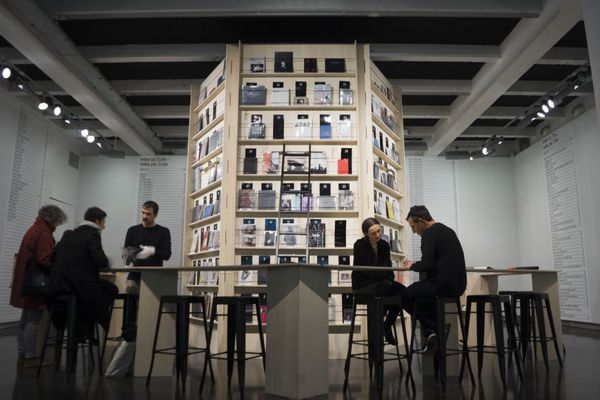
http://www.le-bal.fr/2017/12/surveillance-index
Saturday 20th January - 10am to 6pm: Workshop / Mishka Henner .
Photographer Mishka Henner presents a one-day workshop on image perspectives on networks. More info: http://bit.ly/2DRJFGP
Saturday, January 20th - 8 pm: Scorpion Violente / Concert .
Violent Scorpion will perform in the BAL space and will deploy the synthetic tablecloths of its minimal dark wave hammered hypnotic rhythms. More info: http://bit.ly/2BXY0UP
Wednesday, January 24 - 20h: Mondkopf / Concert .
The Toulouse Mondkopf mixing melodic rhythms and brutality, inspired drone, noise, hip-hop, metal and will perform live at the BAL. More info: http://bit.ly/2CnvPL5
Saturday 27th January - 3pm to 4.30pm: Workshop 'Anonymity' - In collaboration with the hackerspace Reset.
Is it still possible to 'disappear'? The hackerspace The Reset presents a workshop that will give participants tools to protect their data online. More info: http://bit.ly/2CMTk1n
Saturday, January 27th - 5pm : Meeting & Launch of Lewis Bush's book " Shadows of the state"
Related Media
Liberation Par Clémentine Mercier Au Bal à Paris, une exposition d'un monde veilleur
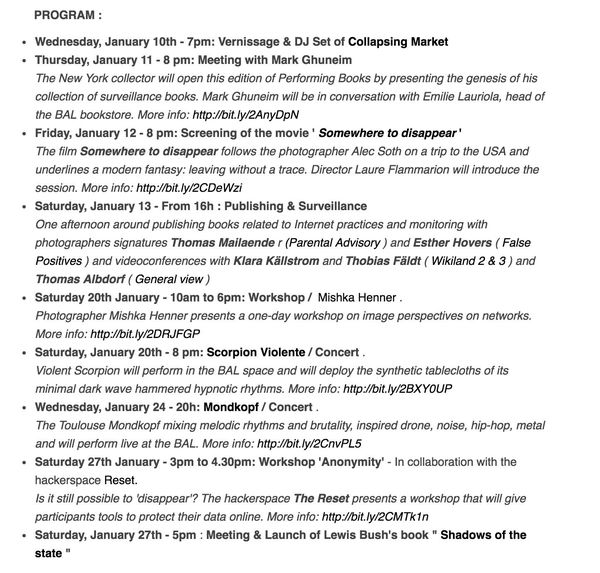
LE BAL LANCE PERFORMING BOOKS.
LE BAL IS LAUNCHING PERFORMING BOOKS. THIS NEW BAL BOOKS INITIATIVE WILL PRESENT A COLLECTION EVERY JANUARY SELECTED BY AN ARTIST, RESEARCHER, OR BOOK LOVER ON A SPECIFIC THEME. LE BAL WILL TURN INTO A RESEARCH LABORATORY FOCUSED ON BOOKS’ ROLE AS A POLITICAL GESTURE AND A CRITICAL REFLECTION OF OUR SOCIETY. THE FIRST PERFORMING BOOKS EVENT IS DEDICATED TO SURVEILLANCE INDEX.
Compiled by the American Mark Ghuneim, this collection of over 200 photography books explores “our the golden age of surveillance” and its visible and invisible inner workings. An expert observer of technological innovation, aware of the challenges of protecting his private life very early on, Ghuneim investigates all the lawful and unlawful procedures the State has put in place to watch its citizens. In the early 1990s, he listed with the American Civil Liberties Union (ACLU) all the CCTV cameras in the streets of New York and created an interactive map which takes you through the parts of Manhattan that aren’t under surveillance. In 2009, six years before the Snowden affair, Ghuneim began collecting books by artists and photographers about “those watching and being watched” men, machines, institutions, governments, spies, hackers, voyeurs and egotists. In LE BAL, over 200 books from his collection Surveillance Index will be available to the public.
« THE ICONOGRAPHY OF SURVEILLANCE IS PART OF OUR DAILY LIVES AND HAS INSPIRED A MULTITUDE OF ARTWORKS » — MARK GHUNEIM
In the spirit of a genuine whistle blower, Ghuneim is raising the alarm, using this collection and the plethora of visual material it represents as a wake-up call raising awareness and resistance. Which personal and collective civil liberties are we sacrificing at the altar of security? How do our personal, intimate, identifying desires create the tools to control us? Which political, social, cultural and legal incidents has this provoked? What behaviour can we adopt in order to disappear from the CCTV screens and meta-databases? To discuss these questions and stimulate public debate, LE BAL has invited sociologists, activists, artists, thinkers and journalists to participate in the programme.
Mark Ghuneim will open Performing Books by discussing the starting point and activist nature of his collection and his self-published 2017 book Surveillance Index which details the inventory of his findings.
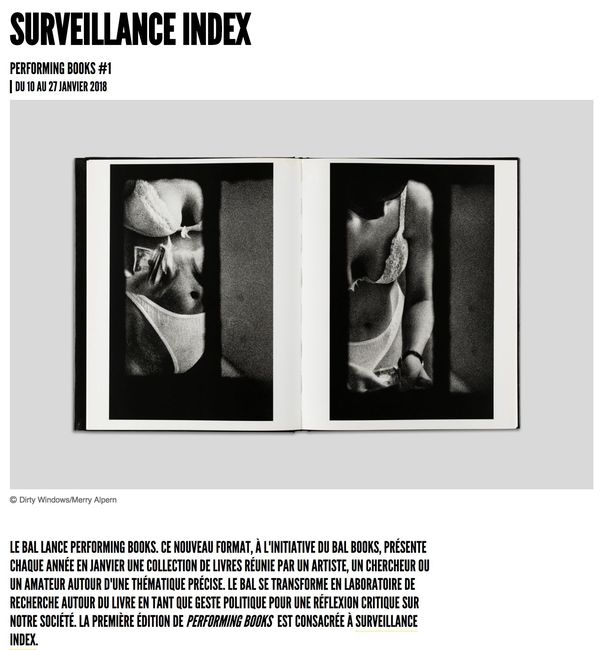
An additional 111 books have been curated, added to the database and will eventually make its way online.

10x10 AWAKE at Magnum Foundation
Protest, Liberty and Resistance Reading Room, Book & Zine Bazaar
Web affairs Show-n-tell -
Allucquere Rosanne Stone
West Garden - Lynch, Dylan
While I have fears that I may cease to be what wold you give me in exchange for your soul
Wikiland 2007-07-12 – 00:59:46
Källström, Klara; Fäldt, Thobias
I loved my wife (Killing children is good for the economy) Dieter De Lathuwer
The Mechanism - Mårten Lange
Tokyo Depression Final Cut - Michael Wolf
Revolutionary Archive - Jochem Hendricks and Magdalena Kopp
While at Photo London we regarded a special tour of Edmund Clark’s - Control Order House exhibition at
the Imperial War Museum. Edmund was recently awarded the 2017 Infinity Award for Photojournalism for his project Negative Publicity. His work is featured in our index.
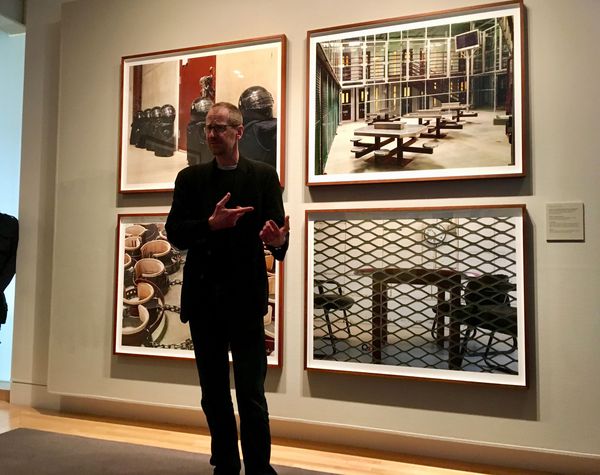
Surveillance Index Edition One will be included in the AWAKE Reading Room at the Carnegie Museum of Art during the PGH Photo Fair from 29-30 April.
Awake! is a space where your voices and your eyes do not have to be compromised. By sharing all your ideas and creations together, we can establish some clarity on our communal thoughts and utilize this information to establish a true and coherent opposition to the tyrannies that are currently trying to erode our liberties, rights and freedoms that have taken generations of struggle to achieve.
Shenasnameh - Photographs by Amak Mahmoodian
Watched! Surveillance, Art and Photography -
Document - By Henry Leutwyler
Negative Publicity: Artefacts of Extraordinary Rendition By Crofton Black and Edmund Clark
Mexican Crime Photographs from the archive of Stefan Ruiz
Under Surveil-Lance - Revolver Publishing
Tearoom - Willam E. Jones
Tekerrur Recurrence - Selim Sume
Each week new books are added into the archive and tagged for Edition Two. Will use this space to document what works are being considered. If you have a related relevant work, and would like it added into the collection please get in touch.

Offprint Paris 2016. If you are in town for either the photography fair or Offprint and would like a copy of Surveillance Index Edition One you can collect one exclusively at Le Bal Books bookshop of the art institution Le Bal in Paris.
Le Bal Books 6 Impasse de la Défense 75018 Paris, France
They have signed copies with an additional special edition two sided poster that acts as both a index for the book and a wall poster. All copies of Surveillance Index Edition One come with a colour poster and bookmark.
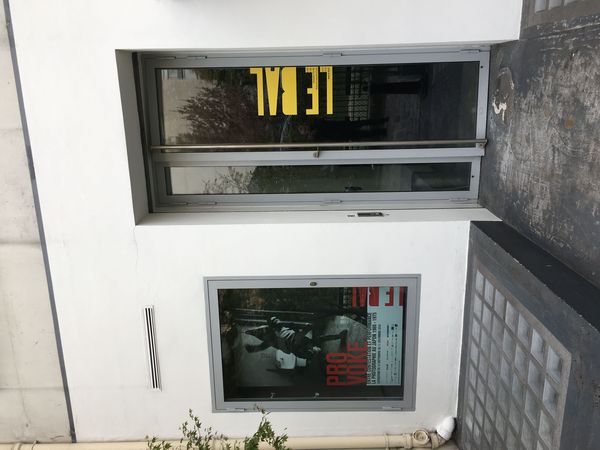
You can find a copy of Surveillance Index Edition One
New York City
Dashwood Books
Printed Matter
McNally Jackson
Spaces Corners @ ICP Bowery
London
Claire De Rouen Books
Paris
LE BAL Books
File under: Surveillance Photography
The NYC launch of Surveillance Index Edition One took place at the Spaces Corners Book store at the International Center of Photography on the Bowery on Thursday 15 September. During the Art Book Fair in NYC.
The most gracious Spaces Corners team and the ICP hosted an event that was well attended and surveilled. Attendees who purchased a copy received a special limited edition two sided poster.
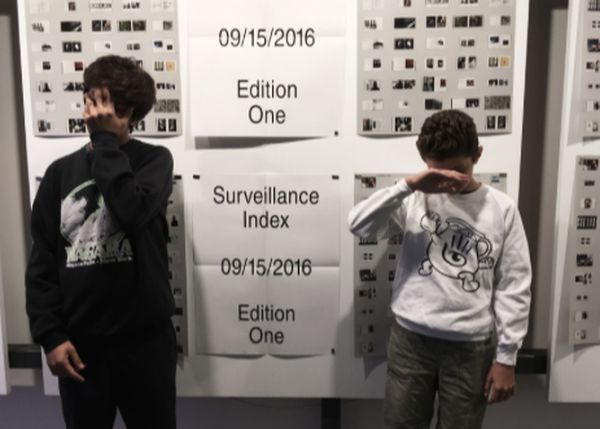
Produced & Published by Mediaeater 2016
Edited by Mark Ghuneim
Designer: Studio Lin
Technical Programming: Brazen
@2016 Mediaeater
for the Surveillance Index,
the photographers and publishers
for their respective works.
$50
11 x 14 inches
Softcover
324 pages
with full color poster
and bookmark
US domestic shipping only.
Mail for international mailing options and distribution inquiries
markghuneim@gmail.com
Produced & Published by Mediaeater 2016
Edited by Mark Ghuneim
Designer: Studio Lin
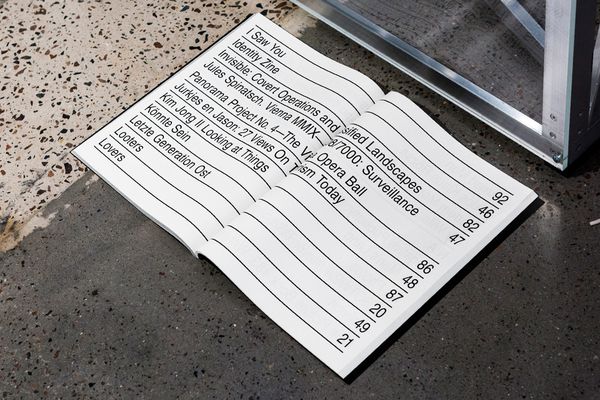
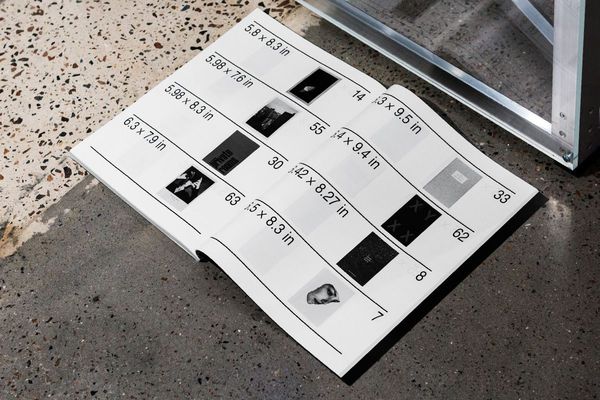

11 x 14 inches
Softcover
324 pages
with full color poster
and bookmark
US domestic shipping only.
Mail for international mailing options and distribution inquiries
markghuneim@gmail.com
Produced & Published by Mediaeater 2016
Edited by Mark Ghuneim
Designer: Studio Lin



The Eyes Have It by Carlo McCormick
Ubiquitous, anonymous, unnoticed, and omnipresent, CCTV cameras are the eyes of a perpetual surveillance state where fear has overtaken the societal and individual concerns for privacy. For many people this is simply the cost of safety, the new normal in a world where the body politic cedes autonomy to the Orwellian meta-government of Big Brother. While fear may inure populations to give up liberty in the name of security, certain artists have proven constitutionally unfit for such acquiescence. Perhaps because art is by nature predicated on a primary act of observation; maybe it is because it believes too adamantly in the dominion of the self to tolerate any major compromise in personal autonomy; or possibly voyeuristic mediums attract one another by their mutual perversity. Whatever the reasons, artists have been addressing the psychological, material, social, and political implications of surveillance with an acuity that almost makes up for the obliviousness the rest of us exercise in failing to look back at that which looks at us.
At this point, the field of surveillance is so expansive and pervasive that we can’t really fathom its presence beyond whatever intimidating statistics could possibly account for it. The numbers are just too vast and absurd, like trying to count warheads at the height of the Cold War arms race, and yet CCTV cameras continue to accumulate like a kind of toxic pollutant in public space, something most of us choose to ignore most of the time because they’re just so damn annoying to pay attention to, unpleasant, weird, and paranoid to talk about with others, and truly disturbing to think about. No, like most irritants in urban life, be it noise pollution, germs, crowds, or just some funky smell, we don’t register the cameras watching us any more often than we bother to look up at the sky above. And habits teach us that we’re not likely to do either unless someone points our gaze in that direction. This of course, is what art is very good at, redirecting our regard with a critical scrutiny not evident in passive observation. Let us then consider how art has captured these televisual spies, what it has seen by looking back directly into the lens, and how that reflection describes our culture.
New technologies often find early adopters in artists who explore its possibilities with the pioneering optimism of discovery. If we had to define a dominant aesthetic for surveillance art today, we might describe it as part of the greater dystopian dread of Trevor Paglen’s meticulous and mesmerizing survey of surveillance photos. But it’s not always been this dire. As we think back on the inventions of aviation and photography, which eventually would enable the automation of surveillance, we recognize that aerial photography offered new ways of seeing, which in turn informed new techniques of representation and styles of abstraction that defined modern art. Similarly, the first explorations of CCTV came from video artists more interested in figuring out how these cameras could be used as tools than in passing judgment on its social ramifications. One of the first exhibitions to feature CCTV cameras was a two-gallery show in San Francisco and New York that offered the now-quaint possibility for attendees at each space to see people on the opposite coast. Back then, in the early ’70s, it was harmless and naïve, people just waving to a camera like an impossible friend. That would soon change.
With an impeccably nefarious pedigree, Closed Caption Television was invented in Germany in 1942 to monitor the firing of V-2 long-range ballistic rockets against allied cities, and found commercial use in the late ’60s and early ’70s for home security and municipal crime prevention. Because these systems offered no way to record what the camera was seeing, their application was limited by the fact that someone had to be watching on a monitor. Then technology allowed taping the camera feed with the VCR in the ’70s, and adapted digital multiplexing, time-lapse, and motion triggers in the ’90s. Surveillance became not only cheaper, easier, and more widespread, but also independent of direct human oversight; it became creepily and coldly anonymous, not somebody looking but something watching. Because video art was born out of closed-circuit television, it is difficult to easily distinguish the medium from the message, but let us survey a few significant works by video pioneers to outline the formal and social potentials uncovered at the dawn of CCTV.
Widely regarded as a landmark in video art, Wipe Cycle (1969) was a collaboration between Frank Gillette and Ira Schneider that helped usher in the new medium of interactive video installations. Mixing prerecorded video with CCTV images of the audience, Wipe Cycle created a succession of feedback loops that drew attention to the process rather than allowing the usual emphasis on image alone. This kind of system aesthetics would provide a whole new language for politically and socially engaged art, notably in Juan Downey’s epic travel cycle Video Trans Americas. As Downey went to Mexico, Guatemala, Peru, Bolivia, and Chile between 1973 and 1976, he recorded indigenous people and showed the documentary-style footage to them and to people he met along the way. Less anthropologist than cultural ambassador, Downey’s acknowledgment of his subjects and audience created a feedback loop for the usually unilateral observation of CCTV.
Der Riese (The Giant), a sprawling eighty-two-minute visual poem on the stark tones and warrantless scrutiny of CCTV, created in 1983 by artist Michael Klier, represents that moment when surveillance moved from anomaly to norm, from something benign in nature to an unmistakably Orwellian paradigm. Constructed out of the surveillance tapes of a small German town, Der Riese is the size and shape of constant observation and diminished privacy, of all that is captured in the cold eye of CCTV, an unrelenting narrative set to a rousing score of Mahler and Wagner in which the mundane and totalitarian converge. The recording is not so much a truth as an accident, a predetermined focus that ultimately unfolds as pure chance. This fact was brought to shocking light when cyber-artist Wolfgang Staehle, who sets up surveillance cameras to record in real time and then creates pictorial equivalents of subjects ranging from Hudson School landscapes to the Empire State Building (in homage to Warhol’s Empire, from 1964), captured the suddenness of history when a camera he had installed on the Brooklyn Bridge filmed the events of 9/11 with brutally clinical precision.
Before we leave aside the impact that CCTV has had on video art, by the preference of this author it is worth examining how this medium, which has become increasingly fraught with emotional and social complexity, has also left room for subversive and wily humor, as in the work of Cuban-American artist Tony Labat. Beginning in the mid-’80s, Labat was one of the first artists who began using CCTV in installations not merely as a system for recording and taping images but as a specific signifier for the ways surveillance functions in our society. Quirky and uncomfortable, these works—like The Tongue in the Position When at Rest (1987), in which the power to run the camera, lighting, and monitor are provided by mice in a cage, running on a wheel—examined the hidden authority of CCTV as both frightening and funny. This strategy of simultaneously hiding and showing the apparatus of surveillance created an even more disorienting frisson in Labat’s Day Labor: Mapping the Outside (Fat Chance Bruce Nauman) (2005), in which the cameras, hidden inside plastic plants installed outside the window of his studio, invoked a kind of kitsch terror as they documented, for six months, the sundry activities of immigrant laborers congregated in the parking lot across the street.
As a production tool and material presence in video art, CCTV has had an innovative and positive effect as well as extremely negative connotations. In street art, another visual-art form that has consistently addressed this technology, surveillance is not seen as a tool but rather as a subject ripe for assault and ridicule by whatever means necessary. Provocateurs and interventionists of the public square, street artists are the vox populi who act as watchdogs of that realm, defying the easy intrusion of surveillance through derisive exaggeration and confrontational polemics. Like unruly delinquents gate-crashing the emperor’s new fashion show, street artists only need to point to the obvious that we try so hard to ignore and laugh off. From the conceptual to the satirical, their attentions have proven to be wildly effective in drawing attention to the social controls invested in surveillance systems.
Some of the most popular parodies come from the biggest names in street art. Shepard Fairey addressed CCTV in silkscreen prints, alternately warning that we are “under surveillance” by his mock corporation Giant and, highlighted by a smoking gun, that we must protect ourselves from the “home invasion” of intrusive surveillance. Banksy’s numerous volleys against the ubiquity of CCTV in England include the large mural One Nation Under CCTV and the deftly simple stencil “what are you looking at?” applied directly in front of a surveillance camera’s field of vision. While CCTV cameras continue to migrate into the gallery in sculptural form—notably Ai Wei Wei’s solid marble surveillance camera—they have been in situ targets of unrelenting vitriol in urban art. Brad Downey, most widely known for his absurd deformations of common city structures like park benches or streetlights, created CCTV Sacrifice (2009) for CNN, in which a surveillance camera on a pole was set on fire. He also has an ongoing series called CCTV Takedown (2007–) in which diptychs of before-and-after photos showing surveillance cameras in place and then absent are hung next to the cameras he has presumably stolen. And while Biancoshock, the Italian master of ludicrous logic, covered a camera with a police helmet, the Dutch artist duo Front 404 bedecked CCTV cameras throughout the city of Utrecht in silly birthday hats to mark George Orwell’s birthday.
As these cameras continue to populate our cities, we must ask ourselves how many are enough, and what exactly needs to be watched to guarantee our security. SpY, an artist based in Spain, brought this question to a hysterical extreme when he installed one hundred surveillance cameras on the side of a building. But it was the French prankster known as The Wa who found the liminal space in this field of vision with his 2012 piece in Warsaw, Master Piss, in which he documented an unseen crime, in the form of a puddle of urine, exactly between two CCTV cameras pointing in opposite directions down a long corridor. Like many crimes committed in protest of this surveillance state, the evidence is not collected by the invasive architecture of CCTV cameras but documented like little ruptures in the surface of control by the artists themselves. We must ask what the real utility of this perpetual recording ultimately is. We see the atrocities of the world as an ongoing stream of surveillance incapable of producing the empathy or the understanding we need to bring an end to the violence. While these grainy shots that show us glimpses of terror before breaking off in bright flashes of explosive destruction may have some forensic, investigative value after the fact, seeing does not equal prevention here any more than the erosion of privacy increases safety. Rather, now we have on this CCTV planet a vast monument to our collective fear, an unfeeling, unthinking, and unworthy witness to the trauma of being.
— Carlo McCormick, New York City, 2016
Surveillance Index Edition One is a collection of one hundred books related to surveillance photography.
Books are indexed by Year, Title, Photographer, Description, Size, and Code.
2023 Welcome to the machine and long polling cameras that connect to AI for X
Now available through Twelve Books in Japan
アメリカ人インターネット起業家、マーク・グネイム(Mark Ghuneim)の作品集。監視写真に関連する100冊の本をまとめた包括的な参考資料集。本書は、監視とそこから生まれたイメージが私たちの生活にとって切っても切り離せない一部となった時代と、アーティストたちが向かい合ってきた主題の記録である。収録されている文化評論家のカーロ・マコーミック(Carlo McCormick)のエッセイ『The Eyes Have It』は、歴史的な背景を説明し、この監視という劇場に先立って存在する美術史の中の例を詳細に分析する。本書は参考資料としてデザインされており、全ての作品が出版年、題名、撮影者、解説、サイズ、コードで索引付けされている。さらに各冊の代表的な見開きページと独自の説明に加え、全ての収録書籍が掲載されたポスター、オリジナルバッグ付き。

Each edition of the book now ships with new black and silver tote bags.

Tim Head - The Tyranny of Reason this may be the one of the first art/photography books that deals with public surveillance

surveillance photography

Archiv Peter Piller
Piller, Peter
Lingering Ghosts
Irvin, Sam
Zus
Fougeirol, Benoît
MY TV Girls
Girard, Sebastien
Restricted Images: Made with the Warlpiri of Central Australia
Waterhouse, Patrick
Palimpsest
Braquenier, Philippe
Robert F. Kennedy Funeral Train: The People’s View
Terpstra, Rein Jelle
Phenotypes/Limited Forms
Linke, Armin; Hanappe, Peter
New York
Gozu, Masao
Art Peace China Daily
Joachim Schmid
Are You Searching For Me?
Joachim Schmid
X Marks the Spot
Joachim Schmid
The Diary of Tom Wilkins
Girard, Sebastien
Sixty-Eight Minutes on the Sunset Strip
Joachim Schmid
The book - From the inaugural ICP exhibition of the same title (co-curated and named by yours truly) This publication came out exceptional.
Public, Private, Secret: On Photography and the Configuration of Self By Charlotte Cotton .
With Marina Chao and Pauline Vermare Contributions by Lacy Austin, David A. Banks, Ben Burbridge, Dan Bustillo, common room, Mark Ghuneim, Johanna Hedva, Romke Hoogwaerts, Elizabeth Kilroy, Joseph Maida, Marisa Olson, David Reinfurt, Daniel Rubinstein, and Lucas Wrench Interviews with Merry Alpern, Zach Blas, Natalie Bookchin, Nancy Burson, Kate Cooper, Lyle Ashton Harris, Ann Hirsch, John Houck, Trevor Paglen, Martine Syms, and Shelly Silver
Copublished by Aperture and the International Center of Photograph
Visvaldas Morkevicius - Public Secrets
Wikiland 23/6/17
RAF No Evidence - Kein Beweis
DMZ - Park Jung Woo
Shadows of the State - Lewis Bush
False Positives - Esther Hovers

The first edition of PERFORMING BOOKS at LE BAL was dedicated to SURVEILLANCE INDEX.

http://www.le-bal.fr/2017/12/surveillance-index
Saturday 20th January - 10am to 6pm: Workshop / Mishka Henner .
Photographer Mishka Henner presents a one-day workshop on image perspectives on networks. More info: http://bit.ly/2DRJFGP
Saturday, January 20th - 8 pm: Scorpion Violente / Concert .
Violent Scorpion will perform in the BAL space and will deploy the synthetic tablecloths of its minimal dark wave hammered hypnotic rhythms. More info: http://bit.ly/2BXY0UP
Wednesday, January 24 - 20h: Mondkopf / Concert .
The Toulouse Mondkopf mixing melodic rhythms and brutality, inspired drone, noise, hip-hop, metal and will perform live at the BAL. More info: http://bit.ly/2CnvPL5
Saturday 27th January - 3pm to 4.30pm: Workshop 'Anonymity' - In collaboration with the hackerspace Reset.
Is it still possible to 'disappear'? The hackerspace The Reset presents a workshop that will give participants tools to protect their data online. More info: http://bit.ly/2CMTk1n
Saturday, January 27th - 5pm : Meeting & Launch of Lewis Bush's book " Shadows of the state"
Related Media
Liberation Par Clémentine Mercier Au Bal à Paris, une exposition d'un monde veilleur

LE BAL LANCE PERFORMING BOOKS.
LE BAL IS LAUNCHING PERFORMING BOOKS. THIS NEW BAL BOOKS INITIATIVE WILL PRESENT A COLLECTION EVERY JANUARY SELECTED BY AN ARTIST, RESEARCHER, OR BOOK LOVER ON A SPECIFIC THEME. LE BAL WILL TURN INTO A RESEARCH LABORATORY FOCUSED ON BOOKS’ ROLE AS A POLITICAL GESTURE AND A CRITICAL REFLECTION OF OUR SOCIETY. THE FIRST PERFORMING BOOKS EVENT IS DEDICATED TO SURVEILLANCE INDEX.
Compiled by the American Mark Ghuneim, this collection of over 200 photography books explores “our the golden age of surveillance” and its visible and invisible inner workings. An expert observer of technological innovation, aware of the challenges of protecting his private life very early on, Ghuneim investigates all the lawful and unlawful procedures the State has put in place to watch its citizens. In the early 1990s, he listed with the American Civil Liberties Union (ACLU) all the CCTV cameras in the streets of New York and created an interactive map which takes you through the parts of Manhattan that aren’t under surveillance. In 2009, six years before the Snowden affair, Ghuneim began collecting books by artists and photographers about “those watching and being watched” men, machines, institutions, governments, spies, hackers, voyeurs and egotists. In LE BAL, over 200 books from his collection Surveillance Index will be available to the public.
« THE ICONOGRAPHY OF SURVEILLANCE IS PART OF OUR DAILY LIVES AND HAS INSPIRED A MULTITUDE OF ARTWORKS » — MARK GHUNEIM
In the spirit of a genuine whistle blower, Ghuneim is raising the alarm, using this collection and the plethora of visual material it represents as a wake-up call raising awareness and resistance. Which personal and collective civil liberties are we sacrificing at the altar of security? How do our personal, intimate, identifying desires create the tools to control us? Which political, social, cultural and legal incidents has this provoked? What behaviour can we adopt in order to disappear from the CCTV screens and meta-databases? To discuss these questions and stimulate public debate, LE BAL has invited sociologists, activists, artists, thinkers and journalists to participate in the programme.
Mark Ghuneim will open Performing Books by discussing the starting point and activist nature of his collection and his self-published 2017 book Surveillance Index which details the inventory of his findings.

An additional 111 books have been curated, added to the database and will eventually make its way online.

10x10 AWAKE at Magnum Foundation
Protest, Liberty and Resistance Reading Room, Book & Zine Bazaar
Web affairs Show-n-tell -
Allucquere Rosanne Stone
West Garden - Lynch, Dylan
While I have fears that I may cease to be what wold you give me in exchange for your soul
Wikiland 2007-07-12 – 00:59:46
Källström, Klara; Fäldt, Thobias
I loved my wife (Killing children is good for the economy) Dieter De Lathuwer
The Mechanism - Mårten Lange
Tokyo Depression Final Cut - Michael Wolf
Revolutionary Archive - Jochem Hendricks and Magdalena Kopp
While at Photo London we regarded a special tour of Edmund Clark’s - Control Order House exhibition at
the Imperial War Museum. Edmund was recently awarded the 2017 Infinity Award for Photojournalism for his project Negative Publicity. His work is featured in our index.

Surveillance Index Edition One will be included in the AWAKE Reading Room at the Carnegie Museum of Art during the PGH Photo Fair from 29-30 April.
Awake! is a space where your voices and your eyes do not have to be compromised. By sharing all your ideas and creations together, we can establish some clarity on our communal thoughts and utilize this information to establish a true and coherent opposition to the tyrannies that are currently trying to erode our liberties, rights and freedoms that have taken generations of struggle to achieve.
Shenasnameh - Photographs by Amak Mahmoodian
Watched! Surveillance, Art and Photography -
Document - By Henry Leutwyler
Negative Publicity: Artefacts of Extraordinary Rendition By Crofton Black and Edmund Clark
Mexican Crime Photographs from the archive of Stefan Ruiz
Under Surveil-Lance - Revolver Publishing
Tearoom - Willam E. Jones
Tekerrur Recurrence - Selim Sume
Each week new books are added into the archive and tagged for Edition Two. Will use this space to document what works are being considered. If you have a related relevant work, and would like it added into the collection please get in touch.

Offprint Paris 2016. If you are in town for either the photography fair or Offprint and would like a copy of Surveillance Index Edition One you can collect one exclusively at Le Bal Books bookshop of the art institution Le Bal in Paris.
Le Bal Books 6 Impasse de la Défense 75018 Paris, France
They have signed copies with an additional special edition two sided poster that acts as both a index for the book and a wall poster. All copies of Surveillance Index Edition One come with a colour poster and bookmark.

You can find a copy of Surveillance Index Edition One
New York City
Dashwood Books
Printed Matter
McNally Jackson
Spaces Corners @ ICP Bowery
London
Claire De Rouen Books
Paris
LE BAL Books
File under: Surveillance Photography
The NYC launch of Surveillance Index Edition One took place at the Spaces Corners Book store at the International Center of Photography on the Bowery on Thursday 15 September. During the Art Book Fair in NYC.
The most gracious Spaces Corners team and the ICP hosted an event that was well attended and surveilled. Attendees who purchased a copy received a special limited edition two sided poster.

Produced & Published by Mediaeater 2016
Edited by Mark Ghuneim
Designer: Studio Lin
Technical Programming: Brazen
@2016 Mediaeater
for the Surveillance Index,
the photographers and publishers
for their respective works.
$50
11 x 14 inches
Softcover
324 pages
with full color poster
and bookmark
US domestic shipping only.
Mail for international mailing options and distribution inquiries
markghuneim@gmail.com
Produced & Published by Mediaeater 2016
Edited by Mark Ghuneim
Designer: Studio Lin



11 x 14 inches
Softcover
324 pages
with full color poster
and bookmark
US domestic shipping only.
Mail for international mailing options and distribution inquiries
markghuneim@gmail.com
Produced & Published by Mediaeater 2016
Edited by Mark Ghuneim
Designer: Studio Lin



The Eyes Have It by Carlo McCormick
Ubiquitous, anonymous, unnoticed, and omnipresent, CCTV cameras are the eyes of a perpetual surveillance state where fear has overtaken the societal and individual concerns for privacy. For many people this is simply the cost of safety, the new normal in a world where the body politic cedes autonomy to the Orwellian meta-government of Big Brother. While fear may inure populations to give up liberty in the name of security, certain artists have proven constitutionally unfit for such acquiescence. Perhaps because art is by nature predicated on a primary act of observation; maybe it is because it believes too adamantly in the dominion of the self to tolerate any major compromise in personal autonomy; or possibly voyeuristic mediums attract one another by their mutual perversity. Whatever the reasons, artists have been addressing the psychological, material, social, and political implications of surveillance with an acuity that almost makes up for the obliviousness the rest of us exercise in failing to look back at that which looks at us.
At this point, the field of surveillance is so expansive and pervasive that we can’t really fathom its presence beyond whatever intimidating statistics could possibly account for it. The numbers are just too vast and absurd, like trying to count warheads at the height of the Cold War arms race, and yet CCTV cameras continue to accumulate like a kind of toxic pollutant in public space, something most of us choose to ignore most of the time because they’re just so damn annoying to pay attention to, unpleasant, weird, and paranoid to talk about with others, and truly disturbing to think about. No, like most irritants in urban life, be it noise pollution, germs, crowds, or just some funky smell, we don’t register the cameras watching us any more often than we bother to look up at the sky above. And habits teach us that we’re not likely to do either unless someone points our gaze in that direction. This of course, is what art is very good at, redirecting our regard with a critical scrutiny not evident in passive observation. Let us then consider how art has captured these televisual spies, what it has seen by looking back directly into the lens, and how that reflection describes our culture.
New technologies often find early adopters in artists who explore its possibilities with the pioneering optimism of discovery. If we had to define a dominant aesthetic for surveillance art today, we might describe it as part of the greater dystopian dread of Trevor Paglen’s meticulous and mesmerizing survey of surveillance photos. But it’s not always been this dire. As we think back on the inventions of aviation and photography, which eventually would enable the automation of surveillance, we recognize that aerial photography offered new ways of seeing, which in turn informed new techniques of representation and styles of abstraction that defined modern art. Similarly, the first explorations of CCTV came from video artists more interested in figuring out how these cameras could be used as tools than in passing judgment on its social ramifications. One of the first exhibitions to feature CCTV cameras was a two-gallery show in San Francisco and New York that offered the now-quaint possibility for attendees at each space to see people on the opposite coast. Back then, in the early ’70s, it was harmless and naïve, people just waving to a camera like an impossible friend. That would soon change.
With an impeccably nefarious pedigree, Closed Caption Television was invented in Germany in 1942 to monitor the firing of V-2 long-range ballistic rockets against allied cities, and found commercial use in the late ’60s and early ’70s for home security and municipal crime prevention. Because these systems offered no way to record what the camera was seeing, their application was limited by the fact that someone had to be watching on a monitor. Then technology allowed taping the camera feed with the VCR in the ’70s, and adapted digital multiplexing, time-lapse, and motion triggers in the ’90s. Surveillance became not only cheaper, easier, and more widespread, but also independent of direct human oversight; it became creepily and coldly anonymous, not somebody looking but something watching. Because video art was born out of closed-circuit television, it is difficult to easily distinguish the medium from the message, but let us survey a few significant works by video pioneers to outline the formal and social potentials uncovered at the dawn of CCTV.
Widely regarded as a landmark in video art, Wipe Cycle (1969) was a collaboration between Frank Gillette and Ira Schneider that helped usher in the new medium of interactive video installations. Mixing prerecorded video with CCTV images of the audience, Wipe Cycle created a succession of feedback loops that drew attention to the process rather than allowing the usual emphasis on image alone. This kind of system aesthetics would provide a whole new language for politically and socially engaged art, notably in Juan Downey’s epic travel cycle Video Trans Americas. As Downey went to Mexico, Guatemala, Peru, Bolivia, and Chile between 1973 and 1976, he recorded indigenous people and showed the documentary-style footage to them and to people he met along the way. Less anthropologist than cultural ambassador, Downey’s acknowledgment of his subjects and audience created a feedback loop for the usually unilateral observation of CCTV.
Der Riese (The Giant), a sprawling eighty-two-minute visual poem on the stark tones and warrantless scrutiny of CCTV, created in 1983 by artist Michael Klier, represents that moment when surveillance moved from anomaly to norm, from something benign in nature to an unmistakably Orwellian paradigm. Constructed out of the surveillance tapes of a small German town, Der Riese is the size and shape of constant observation and diminished privacy, of all that is captured in the cold eye of CCTV, an unrelenting narrative set to a rousing score of Mahler and Wagner in which the mundane and totalitarian converge. The recording is not so much a truth as an accident, a predetermined focus that ultimately unfolds as pure chance. This fact was brought to shocking light when cyber-artist Wolfgang Staehle, who sets up surveillance cameras to record in real time and then creates pictorial equivalents of subjects ranging from Hudson School landscapes to the Empire State Building (in homage to Warhol’s Empire, from 1964), captured the suddenness of history when a camera he had installed on the Brooklyn Bridge filmed the events of 9/11 with brutally clinical precision.
Before we leave aside the impact that CCTV has had on video art, by the preference of this author it is worth examining how this medium, which has become increasingly fraught with emotional and social complexity, has also left room for subversive and wily humor, as in the work of Cuban-American artist Tony Labat. Beginning in the mid-’80s, Labat was one of the first artists who began using CCTV in installations not merely as a system for recording and taping images but as a specific signifier for the ways surveillance functions in our society. Quirky and uncomfortable, these works—like The Tongue in the Position When at Rest (1987), in which the power to run the camera, lighting, and monitor are provided by mice in a cage, running on a wheel—examined the hidden authority of CCTV as both frightening and funny. This strategy of simultaneously hiding and showing the apparatus of surveillance created an even more disorienting frisson in Labat’s Day Labor: Mapping the Outside (Fat Chance Bruce Nauman) (2005), in which the cameras, hidden inside plastic plants installed outside the window of his studio, invoked a kind of kitsch terror as they documented, for six months, the sundry activities of immigrant laborers congregated in the parking lot across the street.
As a production tool and material presence in video art, CCTV has had an innovative and positive effect as well as extremely negative connotations. In street art, another visual-art form that has consistently addressed this technology, surveillance is not seen as a tool but rather as a subject ripe for assault and ridicule by whatever means necessary. Provocateurs and interventionists of the public square, street artists are the vox populi who act as watchdogs of that realm, defying the easy intrusion of surveillance through derisive exaggeration and confrontational polemics. Like unruly delinquents gate-crashing the emperor’s new fashion show, street artists only need to point to the obvious that we try so hard to ignore and laugh off. From the conceptual to the satirical, their attentions have proven to be wildly effective in drawing attention to the social controls invested in surveillance systems.
Some of the most popular parodies come from the biggest names in street art. Shepard Fairey addressed CCTV in silkscreen prints, alternately warning that we are “under surveillance” by his mock corporation Giant and, highlighted by a smoking gun, that we must protect ourselves from the “home invasion” of intrusive surveillance. Banksy’s numerous volleys against the ubiquity of CCTV in England include the large mural One Nation Under CCTV and the deftly simple stencil “what are you looking at?” applied directly in front of a surveillance camera’s field of vision. While CCTV cameras continue to migrate into the gallery in sculptural form—notably Ai Wei Wei’s solid marble surveillance camera—they have been in situ targets of unrelenting vitriol in urban art. Brad Downey, most widely known for his absurd deformations of common city structures like park benches or streetlights, created CCTV Sacrifice (2009) for CNN, in which a surveillance camera on a pole was set on fire. He also has an ongoing series called CCTV Takedown (2007–) in which diptychs of before-and-after photos showing surveillance cameras in place and then absent are hung next to the cameras he has presumably stolen. And while Biancoshock, the Italian master of ludicrous logic, covered a camera with a police helmet, the Dutch artist duo Front 404 bedecked CCTV cameras throughout the city of Utrecht in silly birthday hats to mark George Orwell’s birthday.
As these cameras continue to populate our cities, we must ask ourselves how many are enough, and what exactly needs to be watched to guarantee our security. SpY, an artist based in Spain, brought this question to a hysterical extreme when he installed one hundred surveillance cameras on the side of a building. But it was the French prankster known as The Wa who found the liminal space in this field of vision with his 2012 piece in Warsaw, Master Piss, in which he documented an unseen crime, in the form of a puddle of urine, exactly between two CCTV cameras pointing in opposite directions down a long corridor. Like many crimes committed in protest of this surveillance state, the evidence is not collected by the invasive architecture of CCTV cameras but documented like little ruptures in the surface of control by the artists themselves. We must ask what the real utility of this perpetual recording ultimately is. We see the atrocities of the world as an ongoing stream of surveillance incapable of producing the empathy or the understanding we need to bring an end to the violence. While these grainy shots that show us glimpses of terror before breaking off in bright flashes of explosive destruction may have some forensic, investigative value after the fact, seeing does not equal prevention here any more than the erosion of privacy increases safety. Rather, now we have on this CCTV planet a vast monument to our collective fear, an unfeeling, unthinking, and unworthy witness to the trauma of being.
— Carlo McCormick, New York City, 2016